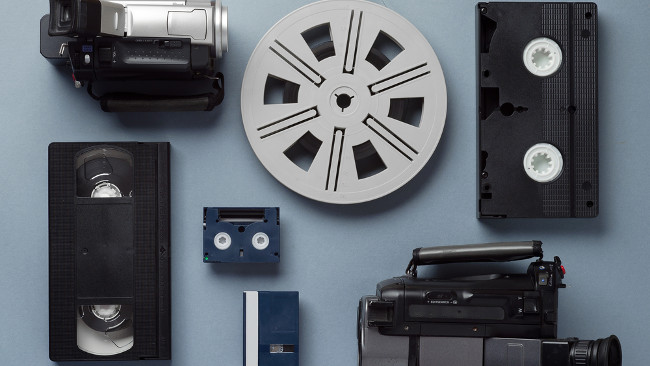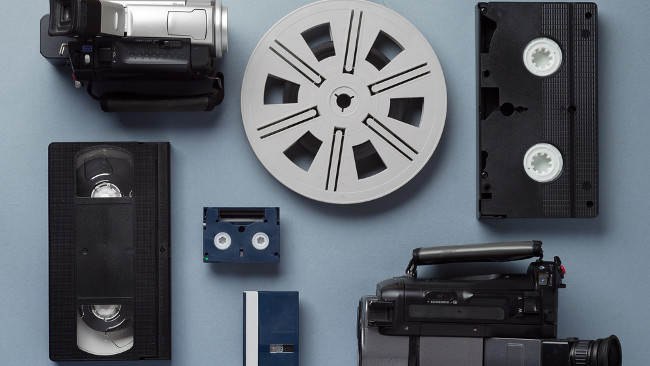
 Tape Graphic by www.shutterstock.com
Tape Graphic by www.shutterstock.com
Remember tape-based workflows and how you would first take a project into offline first before hitting the uber-expensive online suite? Craig Marshall does and that process is still reflected in the way he works today.
I want to explore a once traditional videotape-based post production workflow to see if it still has some merit today. Even with declining costs to shoot, edit and distribute digital HD and 4K video content, the power, price and popularity of software such as DaVinci Resolve means we can entirely avoid the traditional 'round-tripping' workflow, which has became the norm since tape-based video production passed into history.
Celluloid-to-Tape
Back in the mid eighties, I transitioned from being an independent filmmaker working in the traditional 'homespun' craft of celluloid-based documentary filmmaking toward the corporate model of videotape-based production systems, which my contemporaries referred to at the time as 'Work of the Devil'. Some of my short 'indie' docos and promo films were noticed by an Australian Regional Broadcaster on the lookout for talent.
I was contacted and invited to apply for a position with the 'Devil' himself as a Producer/Director. Suffice to say that the salaries offered back then were a sufficient incentive to seduce me away from my bedroom craft-based system and launch myself enthusiastically into the expanding videotape-based infrastructure of the time. In those days, the massive costs associated with broadcast quality post production equipment meant its ownership was squarely in the hands of National Broadcasters or independent Post Facilities with Stock Exchange-based financiers, so working for the Devil was pretty much the only way to get your hands on such expensive hardware.
The Old Off-line/On-line
Because of these high costs, a two tiered production system became commonplace. This was known as the off-line/on-line system and it worked like this: Producers would acquire televised material on broadcast quality videotape (occasionally film, too, but generally Betacam) then have their film telecined or Betacam tapes dubbed to a cheap, common format such as U-Matic or even VHS. This was the equivalent back then of making a Proxy file and these off-line tapes would have the original material's timecode burned into the screen and/or an audio timecode track recorded along with the picture.
Cuts only (no dissolves or wipes) VHS and U-matic edit suites were cheap enough for some well-heeled independents to own outright, but these Proxy off-line suites were often housed in vast warehouses, where producers could go into a hired booth to cheaply organise their material and ultimately perform a 'rough cut' of their pet project. In a basic 'cuts pair', producers would carefully go through their edit, frame-by-frame and manually note with a pencil the inpoint and outpoint of each scene by reading timecode off the screen and recording each scene's tape reel number. In more sophisicated off-line suites, every cut you made automatically logged the timecode of both recorder and player and saved them to a simple DOS file (later Windows 3.1!), where a dot matrix printer would spit out an Edit Decision List (EDL) like a large roll of toilet paper. It was possible on some PC based software to programme in your wipes or dissolves on the computer, where, finally, the software could write the EDL to disk or, better still, upload it directly into an on-line edit controller if it was located in the same building. Here, a B-roll would be made before your programme was finished with transitions, Digital Video Effects, (DVEs) Graphics (stills or animations) and Supers (Tiltes).
This was the situation I found myself in once I eventually escaped the clutches of the Devil and set up on my own again in the early '90s. At the time, a fully fledged on-line videotape production suite with a minimum of three VTRs with an edit controller, vision mixer, audio mixer and some form of character generator, all tied together electronically, could cost in the region of half a million dollars to build. As an independent 'off-line' Producer of the era walking into an on-line suite with a bunch of reels and an EDL print-out, you faced the stopwatch at US$400/hour, so you were well advised to arrive well organised.
Modern Choices
Now, let's Fast Forward to today. I see a pattern emerging now as I shoot digital, I edit with an NLE and I finish in DaVinci Resolve. I could perform both Post operations in the same software and many people do, but for me, old habits die hard. Certain software programmes have become very specialised over the years and as an old 'TV' guy, I love specialised hardware, too, so I still like to edit with a dedicated Jog/Shuttle hardware controller, rather than a Mouse. DaVinci Resolve has morphed from an expensive grading programme demanding a large and bespoke hardware control surface to a freely available resource, which can be used effectively and successfully with only the minimum of dedicated hardware.
Lightworks along with Avid were two of the first, file-based NLEs to make in onto the market in the early '90s. Lightworks even developed a hardware console, which successfully emulated the control system beloved by Kem and Steenbeck 'film' editors and assisted their transition from nonlinear film workflows into nonlinear digital workflows.
Many competing NLEs exist today and all have their devotees, but the early leaders, Avid and Lightworks, are still highly regarded in their fairly specialised markets. Lightworks, for example, has been refined for a modern audience, since it's acquisition by UK company Editshare a few years ago, and it remains one of the few tri-platfom NLEs with a fully functioning free version as well as a 'Buy Outright' or 'Subscribe' professional business model, the latter featuring additional codecs and more export options.
When I was transitioning from broadcast videotape production to a digital file based system, Lightworks seemed to offer me the most 'familiar' interface and I still love the way you can stretch the GUI over as many monitors as you have connected to your computer and customise each window to suit the particular project you are working on at the time. IMO, Lightworks also has the best 'audio scrubbing' in the business with real analogue tape style jog, not the uncomfortable digital audio 'clicks' which are so commonplace on most other NLEs and even the latest versions of DaVinci Resolve.
Edit in one, finish in another
For me, editing is a decision making process which can be very time consuming so I want to concentrate on how well a shot or sequence of cuts flows together without any distractions. I use Lightworks Preview key constantly, where the timeline quickly flips back a few seconds then plays down over the cut for as long as I like to return to my edit point when I hit Stop. Again, this is a tape based feature but still very handy today because good editing demands precise timing.
If we take the traditional but still popular film framerate of 24fps, that's 24 possible edit decisions you need to make for every second of your movie. A frame is either in or it's out so you'd better get it right! Another reason I cut on Lightworks is that it will run on relatively low spec hardware so you can pack your laptop or even a Tablet whilst travelling, plug in your favourite USB Jog/Shuttle controller and contine cutting off-line. What was that? Off-Line? It's the same old two stage process and when all your edit decisions are made, you simply export an EDL/AAF/XML and bring this into Resolve, which I see as today's equivalent of the on-line edit suite where you 'finish' your programme. There's no clumsy 'roundtripping' required with this approach as you work on your original material, thereby potentially saving a generation from Acquisition to Distribution.
Even though the basic Resolve is free to download and install on your PC/Mac, it does requires some specialised hardware to make it really fluent so money spent on a high quality reference monitor which can be accurately calibrated will be money very well spent so why not simply complete everything inside DaVinci Resolve? Well combined with Fusion, Blackmagic Design have provided a sophisticated tool set for everything but the most advanced production requirements.
However, Resolve as an Editor is perhaps not as fine tuned or as 'portable' as other options and is probably best suited to a 'desktop' application so I would suggest film makers who see merit in my off-line/on-line approach, download the latest Lightworks 12.6 from www.lwks.com, watch the on-line Tutorials and have a play. I have found that Lightworks EDLs, AAFs or XMLs will import seamlessly into DaVinci and although the free version of Lightworks does not permit exporting an Edit Decision List, several enthusiastic filmmakers I know have simply bought the cost effective monthly Pro licence 'as required' to Export their film's edit data into Resolve. However, under a special arrangement with Vimeo, Lightworks Free will allow you to upload full HD 1080p movies direct to the popular streaming service for those with only a free 720P Vimeo account. For that reason alone, Lightworks might be worth adding to your app list.
Graphic by Shutterstock
Tags: Post & VFX



Comments